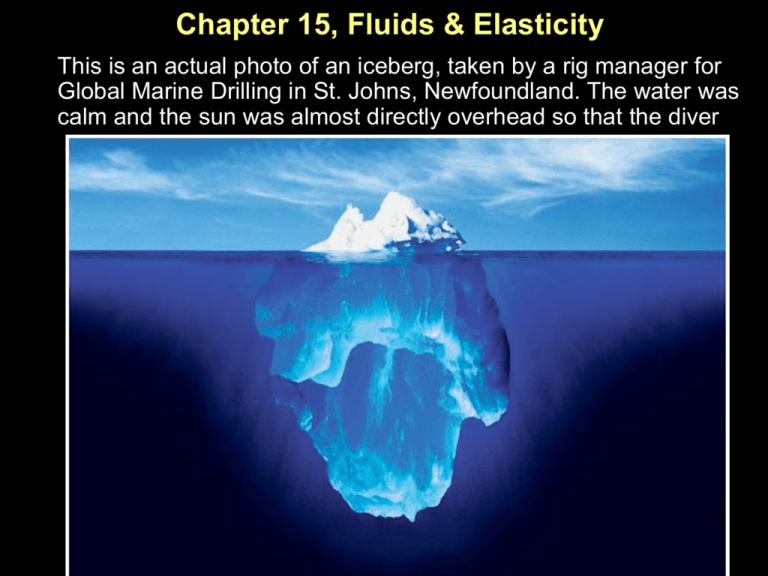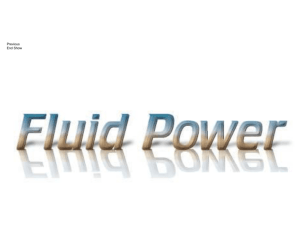Physics 207: Lecture 2 Notes
advertisement

Chapter 15, Fluids & Elasticity This is an actual photo of an iceberg, taken by a rig manager for Global Marine Drilling in St. Johns, Newfoundland. The water was calm and the sun was almost directly overhead so that the diver Physics 207: Lecture 21, Pg 1 Goals: Lecture 21 • Chapter 15 Understand pressure in liquids and gases Use Archimedes’ principle to understand buoyancy Understand the equation of continuity Use an ideal-fluid model to study fluid flow. Investigate the elastic deformation of solids and liquids • Assignment HW10, Due Wednesday, Apr. 14th Thursday: Read all of Chapter 16 Physics 207: Lecture 21, Pg 2 Fluids At ordinary temperature, matter exists in one of three states Solid - has a shape and forms a surface Liquid - has no shape but forms a surface Gas - has no shape and forms no surface What do we mean by “fluids”? Fluids are “substances that flow”…. “substances that take the shape of the container” Atoms and molecules are free to move. No long range correlation between positions. Physics 207: Lecture 21, Pg 3 Fluids An intrinsic parameter of a fluid Density m V units : kg/m3 = 10-3 g/cm3 (water) = 1.000 x 103 kg/m3 = 1.000 g/cm3 (ice) = 0.917 x 103 kg/m3 = 0.917 g/cm3 (air) = 1.29 kg/m3 = 1.29 x 10-3 g/cm3 (Hg) = 13.6 x103 kg/m3 (W or Au) = 19.3 x103 kg/m3 = 13.6 g/cm3 = 19.3 g/cm3 Physics 207: Lecture 21, Pg 4 Fluids F p A Another parameter: Pressure Any force exerted by a fluid is perpendicular to a surface of contact, and is proportional to the area of that surface. Force (a vector) in a fluid can be expressed in terms of pressure (a scalar) as: F pAnˆ n̂ A Physics 207: Lecture 21, Pg 5 What is the SI unit of pressure? A. Pascal B. Atmosphere C. Bernoulli D. Young E. p.s.i. Units : 1 N/m2 1 bar 1 mbar 1 torr = 1 Pa (Pascal) = 105 Pa = 102 Pa = 133.3 Pa 1 atm = 1.013 x105 Pa = 1013 mbar = 760 Torr = 14.7 lb/ in2 (=PSI) Physics 207: Lecture 21, Pg 6 Pressure vs. Depth Incompressible Fluids (liquids) p When the pressure is small, relative to the bulk modulus of the fluid, we can treat the density as constant independent of pressure: incompressible fluid 0 y1 F1 y2 p 1 A p 2 mg F 2 For an incompressible fluid, the density is the same everywhere, but the pressure is NOT! p(y) = p0 - y g Gauge pressure (subtract p0) pGauge = p(y) - p0 F2 = F1+ m g = F1+ Vg F2 /A = F1/A + Vg/A p2 = p1 - g y Physics 207: Lecture 21, Pg 7 Pressure vs. Depth For a uniform fluid in an open container pressure same at a given depth independent of the container y p(y) Fluid level is the same everywhere in a connected container, assuming no surface forces Physics 207: Lecture 21, Pg 8 Pressure Measurements: Barometer Invented by Torricelli A long closed tube is filled with mercury and inverted in a dish of mercury The closed end is nearly a vacuum Measures atmospheric pressure as 1 atm = 0.760 m (of Hg) Physics 207: Lecture 21, Pg 9 Exercise Pressure What happens with two fluids?? dI Consider a U tube containing liquids of density 1 and 2 as shown: 2 1 Compare the densities of the liquids: (A) 1 < 2 (B) 1 = 2 (C) 1 > 2 Physics 207: Lecture 21, Pg 10 Exercise Pressure What happens with two fluids?? Consider a U tube containing liquids of density 1 and 2 as shown: 2 At the red arrow the pressure must be the dI 1 y same on either side. 1 x = 2 (d1+ y) Compare the densities of the liquids: (A) 1 < 2 (B) 1 = 2 (C) 1 > 2 Physics 207: Lecture 21, Pg 11 Archimedes’ Principle: A Eureka Moment Suppose we weigh an object in air (1) and in water (2). W1 W2? How do these weights compare? W1 < W2 W1 = W 2 W1 > W2 Buoyant force is equal to the weight of the fluid displaced Physics 207: Lecture 21, Pg 12 Archimedes’ Principle Suppose we weigh an object in air (1) and in water (2). How do these weights compare? W1 < W2 W 1 = W2 Why? Since the pressure at the bottom of the object is greater than that at the top of the object, the water exerts a net upward force, the buoyant force, on the object. W1 > W 2 W1 W2? Physics 207: Lecture 21, Pg 14 Sink or Float? The buoyant force is equal to the weight of the liquid that is displaced. If the buoyant force is larger than the weight of the object, it will float; otherwise it will sink. y FB mg We can calculate how much of a floating object will be submerged in the liquid: Object is in equilibrium FB mg liquid g Vliquid object g Vobject Vliquid Vobject object liquid Physics 207: Lecture 21, Pg 15 Bar Trick What happens to the water level when the ice melts? Expt. 1 A. It rises Expt. 2 B. It stays the same piece of rock on top of ice C. It drops Physics 207: Lecture 21, Pg 16 Exercise V1 = V2 = V3 = V4 = V5 m1 < m2 < m3 < m4 < m5 What is the final position of each block? Physics 207: Lecture 21, Pg 17 Exercise V1 = V2 = V3 = V4 = V5 m1 < m2 < m3 < m4 < m5 What is the final position of each block? Not this But this Physics 207: Lecture 21, Pg 18 Pascal’s Principle So far we have discovered (using Newton’s Laws): Pressure depends on depth: Dp = - g Dy Pascal’s Principle addresses how a change in pressure is transmitted through a fluid. Any change in the pressure applied to an enclosed fluid is transmitted to every portion of the fluid and to the walls of the containing vessel. Physics 207: Lecture 21, Pg 24 Pascal’s Principle in action: Hydraulics, a force amplifier F1 Consider the system shown: F2 A downward force F1 is applied to the piston of area A1. This force is transmitted through the liquid to create an upward force F2. d2 d1 Pascal’s Principle says that increased pressure from F1 (F1/A1) is transmitted throughout the liquid. A1 A2 P1 = P2 F1 / A1 = F2 / A2 A2 / A1 = F2 / F1 F2 > F1 with conservation of energy Physics 207: Lecture 21, Pg 25 Fluids in Motion To describe fluid motion, we need something that describes flow: Velocity v There are different kinds of fluid flow of varying complexity non-steady / steady compressible / incompressible rotational / irrotational viscous / ideal Physics 207: Lecture 21, Pg 27 Types of Fluid Flow Laminar flow Each particle of the fluid follows a smooth path The paths of the different particles never cross each other The path taken by the particles is called a streamline Turbulent flow An irregular flow characterized by small whirlpool like regions Turbulent flow occurs when the particles go above some critical speed Physics 207: Lecture 21, Pg 28 Types of Fluid Flow Laminar flow Each particle of the fluid follows a smooth path The paths of the different particles never cross each other The path taken by the particles is called a streamline Turbulent flow An irregular flow characterized by small whirlpool like regions Turbulent flow occurs when the particles go above some critical speed Physics 207: Lecture 21, Pg 29 Lecture 21 • Question to ponder: or float? Does heavy water (D2O) ice sink • Assignment HW10, due Wednesday, Apr. 14th Thursday: Read all of Chapter 16 Physics 207: Lecture 21, Pg 30





